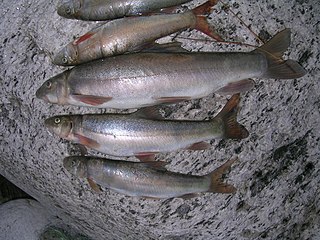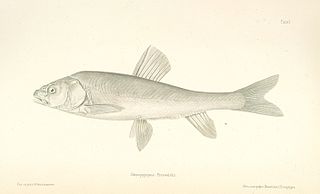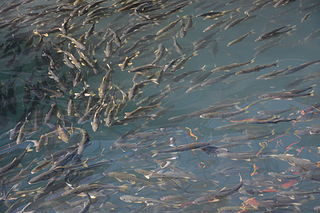
Catfish are a diverse group of ray-finned fish. Named for their prominent barbels, which resemble a cat's whiskers, catfish range in size and behavior from the three largest species alive, the Mekong giant catfish from Southeast Asia, the wels catfish of Eurasia, and the piraíba of South America, to detritivores, and even to a tiny parasitic species commonly called the candiru, Vandellia cirrhosa. Neither the armour-plated types nor the naked types have scales. Despite their name, not all catfish have prominent barbels or "whiskers". Members of the Siluriformes order are defined by features of the skull and swimbladder. Catfish are of considerable commercial importance; many of the larger species are farmed or fished for food. Many of the smaller species, particularly the genus Corydoras, are important in the aquarium hobby. Many catfish are nocturnal, but others are crepuscular or diurnal.

Pisces (♓︎) is the twelfth astrological sign in the Zodiac. It is a negative, mutable sign. It spans 330° to 360° of celestial longitude. Under the tropical zodiac, the sun transits this area between February 19 and March 20. In sidereal astrology, the Sun currently transits the constellation of Pisces from approximately March 12 to April 18. In classical interpretations, the symbol of the fish is derived from the ichthyocentaurs, who aided Aphrodite when she was born from the sea.

Fish are gill-bearing aquatic craniate animals that lack limbs with digits. They form a sister group to the tunicates, together forming the olfactores. Included in this definition are the living hagfish, lampreys, and cartilaginous and bony fish as well as various extinct related groups. Around 99% of living fish species are ray-finned fish, belonging to the class Actinopterygii, with over 95% belonging to the teleost subgrouping.

Diptychus is a genus of cyprinid freshwater fish, consisting of two species found in Himalaya and the Tibetan Plateau of China, India, Nepal and Pakistan, ranging west to the Tien Shan Mountains and Central Asia. The type species is the scaly osman, Diptychus maculatus. The name is derived from the Greek word di, meaning "two", and the Greek word ptyx, meaning "fold". Diptychus is up to 70 cm (2.3 ft) in total length.

Schizothorax is a genus of cyprinid fish found in southern and western China, through northern South Asia (Himalaya) and Central Asia, to Iran, with a single species, S. prophylax, in Turkey. They are primarily found in highland rivers, streams and lakes, although a few species occur in lower-lying locations, like Lake Balkhash and lakes of the Sistan Basin. Their scientific name means "cloven-breast", from Ancient Greek schízeïn (σχίζειν) "to cleave" and thórax (θώραξ) "breast-plate". The western species are typically referred to as marinkas from their Russian name marinka (маринка), while the eastern species are usually called snowtrout. Although they do resemble trouts in habitus this is merely due to convergent evolution and they are by no means closely related apart from both being Teleostei: Cyprinids are in the teleost superorder Ostariophysi, while trouts are in the superorder Protacanthopterygii. Their ancestors must thus have diverged as early as the Triassic, more than 200 million years ago.

Schizopygopsis is a genus of cyprinid fish. Most species are endemic to river basins in the Himalayas and Qinghai–Tibet Plateau of China, but S. stoliczkai extends into the highlands of Afghanistan, Iran, northern India, Kyrgyzstan, Pakistan and Tajikistan.
Chuanchia labiosa is a species of cyprinid fish that is only found in the upper reaches of the Yellow River basin in the Qinghai–Tibet Plateau of China, where it mostly inhabits slow-flowing cold waters at altitudes above 3,000 m (9,800 ft). It is the only member of its genus, but is related to other schizothoracines like Aspiorhynchus, Diptychus, Gymnodiptychus, Gymnocypris, Oxygymnocypris, Platypharodon, Ptychobarbus, Schizopyge, Schizopygopsis and Schizothorax.

Gymnocypris is a genus of fish in the family Cyprinidae endemic to China.
Platypharodon extremus is a species of cyprinid fish endemic to the upper Yellow River basin in the Qinghai–Tibet Plateau of China. It is the only member of its genus, but is related to other schizothoracines like Aspiorhynchus, Chuanchia, Gymnocypris, Oxygymnocypris, Ptychobarbus, Schizopyge, Schizopygopsis and Schizothorax.
Ptychobarbus is a genus of cyprinid fish that is found in rivers, streams and lakes in the Himalayas and Tibetan Plateau of China, India, Nepal and Pakistan, extending into the highlands of Afghanistan. They reach up to 2.2 kg (5 lb) in weight and about 65 cm (2.1 ft) in total length. They mostly feed on benthic invertebrates, but will also take planktonic organisms, aquatic plants and algae.

Li Sizhong was an ichthyologist with the Institute of Zoology (中国科学院动物研究所) at the Chinese Academy of Sciences. Throughout his research career, he made numerous discoveries of new fish species, and published many books and research papers describing the fauna and geographical distribution of fishes in China and beyond. He translated and helped publication of the Chinese editions of Fishes of the World and Fish Migration. Li was the major author of two published volumes in the Fauna Sinica monograph series, systematically reviewing and describing orders of bony fishes that include flat fish, cod, silverside, pearlfish, killifish, flying fish, etc. in or near China. He had written over 40 popular science articles about fish on Chinese newspapers and magazines, and been responsible for compiling and editing fish-related entries in several standard reference books.

Gymnocypris przewalskii is a species of cyprinid that is endemic to the Lake Qinghai basin in China, where it is the dominant fish species. G. przewalskii is a planktivore with a main population that migrates from the lake to rivers to spawn and another that lives its entire life in the nearby Ganzi River. The species is listed as endangered on the China Species Red List due to overfishing and habitat loss, which has led to suspension of its commercial fishery four times since 1989.

The Cyprininae are one of at least 11 subfamilies of cyprinid fish. It contains three genera in its strictest definition but many more are included depending on which authority is defining it, especially if the Labeobarbinae is not considered to be a valid grouping.
Gymnocypris chilianensis is a species of cyprinid fish endemic to China. It may be a synonym of Gymnocypris eckloni.
Gymnocypris chui is a species of cyprinid fish endemic to Tibet.
Gymnocypris dobula is a species of cyprinid fish endemic to China.
Gymnocypris eckloni is a species of cyprinid fish endemic to China.
Gymnocypris potanini is a species of cyprinid fish endemic to China.
Gymnocypris scleracanthus is a species of cyprinid fish endemic to China.
Gymnocypris waddellii is a species of cyprinid fish endemic to Tibet.









